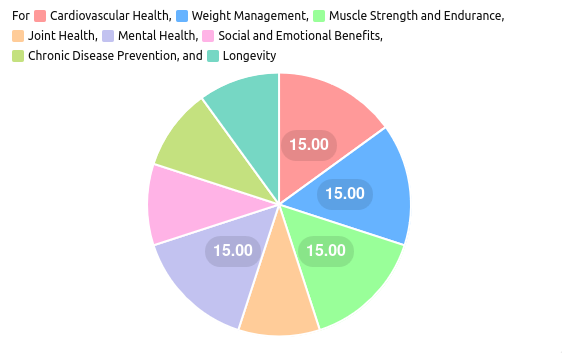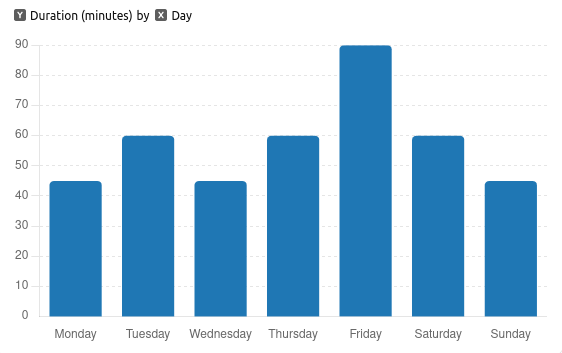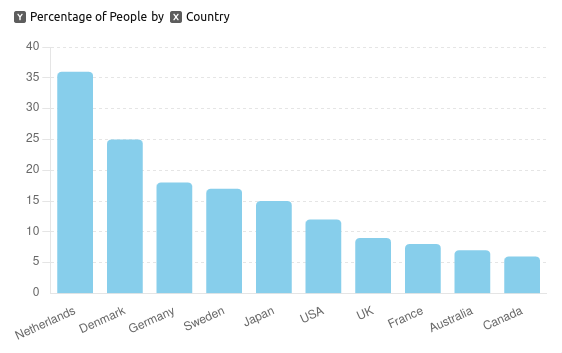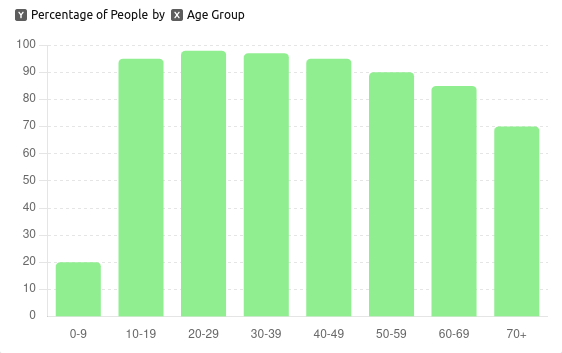Pedal Power: Exploring the Health Benefits and Global Cycling Trends
Pedal Power: Exploring the Health Benefits and Global Cycling Trends

Biking is a fantastic way to improve and maintain overall health. Here are several key health benefits of biking:
1. Cardiovascular Health
- Improves Heart Function: Regular cycling strengthens the heart muscles, lowers resting pulse, and reduces blood fat levels.
- Reduces Risk of Cardiovascular Diseases: It can help lower the risk of heart disease, high blood pressure, and stroke.
2. Weight Management
- Burns Calories: Cycling is an effective way to burn calories and helps in maintaining a healthy weight.
- Boosts Metabolism: It can increase your metabolic rate, even after you have finished your ride.
3. Muscle Strength and Tone
- Strengthens Muscles: It primarily works on the leg muscles but also engages the core and upper body to a lesser extent.
- Improves Muscle Tone: Regular biking can lead to better muscle tone and strength.
4. Joint Health
- Low-Impact Exercise: Cycling is easier on the joints compared to running or other high-impact sports, making it a great option for those with joint issues or arthritis.
- Enhances Joint Mobility: It helps in improving the range of motion of the hips and knees.
5. Mental Health
- Reduces Stress and Anxiety: Physical activity like cycling releases endorphins, which can improve mood and reduce stress levels.
- Boosts Mental Health: Regular exercise can alleviate symptoms of depression and anxiety.
6. Improves Coordination and Balance
- Enhances Coordination: Cycling requires good coordination and balance, which can improve these skills over time.
- Prevents Falls: Better balance can help prevent falls and related injuries, especially as you age.
7. Enhances Immune System
- Boosts Immunity: Moderate exercise can enhance the immune system, making you more resistant to common illnesses.
8. Social Benefits
- Community and Social Interaction: Joining cycling clubs or groups can lead to new friendships and social interactions, which are beneficial for mental health.
- Family Activity: It can be a fun and healthy activity for the whole family.
Tips for Healthy Biking:
- Proper Gear: Wear a helmet, appropriate clothing, and reflective gear if riding in low light.
- Regular Maintenance: Keep your bike in good condition with regular maintenance.
- Stay Hydrated: Drink plenty of water before, during, and after your ride.
- Warm-Up and Cool-Down: Incorporate a warm-up before your ride and a cool-down afterward to prevent injuries.
Incorporating biking into your routine can lead to numerous health benefits, making it a great option for improving and maintaining physical and mental well-being.
| Health Aspect | Benefits |
| Cardiovascular Health | Improves heart function, reduces risk of heart disease |
| Weight Management | Burns calories, increases metabolism |
| Muscle Strength and Endurance | Strengthens leg and core muscles, improves muscle tone |
| Joint Health | Low-impact on joints, enhances joint mobility |
| Mental Health | Reduces stress and anxiety, improves cognitive function |
| Social and Emotional Benefits | Fosters social connections, enhances self-esteem |
| Chronic Disease Prevention | Reduces risk of diabetes and certain cancers |
| Longevity | Increases lifespan, better quality of life |
There is a strong connection between regular cycling and improved health. Here are some detailed ways in which regular cycling can positively impact health:
Physical Health Benefits
- Cardiovascular Health
- Enhanced Heart Health: Regular cycling strengthens the heart muscles, improves blood circulation, and lowers resting pulse rate.
- Reduced Risk of Heart Disease: It helps in lowering blood pressure and cholesterol levels, thereby reducing the risk of heart attacks and strokes.
- Weight Management
- Effective Calorie Burning: Cycling helps burn a significant number of calories, aiding in weight loss and preventing obesity.
- Increased Metabolism: It boosts metabolic rate, helping the body burn more calories even when at rest.
- Muscle Strength and Endurance
- Leg and Core Strength: Cycling targets the quadriceps, hamstrings, calves, and glutes, enhancing muscle strength and endurance.
- Improved Muscle Tone: Consistent cycling leads to better muscle tone, particularly in the lower body.
- Joint Health
- Low-Impact Exercise: Cycling is gentle on the joints, reducing the risk of injury compared to high-impact activities like running.
- Enhanced Joint Mobility: Regular cycling helps maintain joint flexibility and mobility.
Mental Health Benefits
- Stress Reduction
- Release of Endorphins: Physical activity like cycling stimulates the release of endorphins, which can improve mood and reduce stress.
- Lower Anxiety Levels: Regular cycling can help decrease symptoms of anxiety.
- Improved Mental Clarity
- Boosted Cognitive Function: Exercise increases blood flow to the brain, which can improve cognitive function and memory.
- Reduced Risk of Depression: Regular cycling has been linked to lower levels of depression and improved overall mental health.
Social and Emotional Benefits
- Social Interaction
- Community Engagement: Joining cycling clubs or groups fosters social connections and a sense of community.
- Family Bonding: Cycling can be a family-friendly activity, promoting quality time and shared experiences.
- Enhanced Self-Esteem
- Achievement and Goal Setting: Setting and achieving cycling goals can boost self-esteem and confidence.
- Sense of Accomplishment: Completing a challenging ride or improving performance can provide a significant sense of accomplishment.
Long-Term Health Benefits
- Chronic Disease Prevention
- Reduced Risk of Diabetes: Regular physical activity, such as cycling, helps regulate blood sugar levels and reduce the risk of Type 2 diabetes.
- Lowered Risk of Cancer: Studies have shown that regular exercise can reduce the risk of certain types of cancer, including colon and breast cancer.
- Longevity
- Increased Lifespan: Regular physical activity is associated with a longer life expectancy due to improved overall health and reduced risk of chronic diseases.
- Better Quality of Life: Staying active through cycling can lead to a more active and fulfilling life, especially in older age.
Cities Most Convenient for Traveling by Bicycle
| City | Country | Bike Lane Infrastructure (km) | Bike Sharing Programs | Bike Culture & Safety |
| Copenhagen | Denmark | 400 | Bycyklen | Excellent |
| Amsterdam | Netherlands | 767 | OV-fiets | Excellent |
| Portland | USA | 700 | Biketown | Good |
| Berlin | Germany | 1200 | Call a Bike | Good |
| Montreal | Canada | 650 | BIXI | Good |
| Barcelona | Spain | 180 | Bicing | Good |
| Tokyo | Japan | 700 | Docomo Bike Share | Moderate |
| Paris | France | 1000 | Vélib’ | Good |
| Munich | Germany | 1200 | MVG Rad | Good |
| San Francisco | USA | 500 | Ford GoBike | Moderate |
Weekly Cycling Schedule for Staying in Shape

To stay in shape by riding a bike, the amount of cycling needed can vary depending on individual fitness levels, goals, and overall health. Here is a general schedule that balances regular exercise with recovery time, suitable for most adults aiming for general fitness and health benefits:
Weekly Cycling Schedule
Monday
- Type: Rest or Light Activity
- Duration: 30-60 minutes
- Activity: Light stretching, walking, or a gentle bike ride
Tuesday
- Type: Moderate Ride
- Duration: 45-60 minutes
- Intensity: Moderate (60-70% of maximum heart rate)
- Notes: Aim for a steady pace that raises your heart rate but still allows for conversation
Wednesday
- Type: Interval Training
- Duration: 45 minutes
- Intensity: High (includes short bursts of high intensity)
- Schedule:
- 10 minutes warm-up (easy pace)
- 5 sets of 3 minutes high intensity, 2 minutes low intensity
- 10 minutes cool-down (easy pace)
Thursday
- Type: Rest or Cross-Training
- Duration: 30-60 minutes
- Activity: Swimming, yoga, or another low-impact activity
Friday
- Type: Long Ride
- Duration: 60-90 minutes
- Intensity: Moderate (60-70% of maximum heart rate)
- Notes: Focus on endurance and maintaining a steady pace
Saturday
- Type: Hill Training or High-Intensity Ride
- Duration: 45-60 minutes
- Intensity: High (includes climbs or fast-paced segments)
- Notes: Incorporate hill climbs or sprints
Sunday
- Type: Easy Ride
- Duration: 30-45 minutes
- Intensity: Low (50-60% of maximum heart rate)
- Notes: Keep a relaxed pace for active recovery
General Tips
- Warm-Up and Cool-Down: Always include a warm-up and cool-down period to prepare your body for exercise and prevent injuries.
- Hydration and Nutrition: Stay hydrated and maintain a balanced diet to support your cycling activities.
- Listen to Your Body: Adjust the schedule based on how your body feels, especially if you experience pain or fatigue.
- Progress Gradually: Increase duration and intensity gradually to avoid overtraining and injuries.
- Mix It Up: Incorporate different types of rides and activities to keep the routine interesting and comprehensive.
This schedule provides a balanced approach to staying in shape through cycling, combining different types of rides and allowing for adequate rest and recovery. Adjustments can be made based on individual fitness levels and specific goals.
Percentage of People Who Regularly Ride a Bicycle by Country

To feel your best while riding a bike, follow these recommendations for optimal performance, comfort, and safety:
Preparation
- Choose the Right Bike
- Fit: Ensure your bike fits you properly. Visit a bike shop for a professional fitting.
- Type: Select a bike suited to your riding style (e.g., road bike, mountain bike, hybrid).
- Wear Proper Gear
- Helmet: Always wear a helmet for safety.
- Clothing: Wear comfortable, moisture-wicking clothing. Use padded shorts for longer rides.
- Shoes: Wear appropriate cycling shoes for better pedal efficiency.
- Maintain Your Bike
- Regular Checkups: Ensure your bike is in good working condition with regular maintenance.
- Tire Pressure: Check and maintain the proper tire pressure.
- Lubrication: Keep the chain and gears lubricated.
During the Ride
- Warm-Up and Cool-Down
- Warm-Up: Start with a gentle ride for 5-10 minutes to warm up your muscles.
- Cool-Down: End with a slow ride and some stretching to prevent stiffness.
- Pace Yourself
- Steady Pace: Maintain a steady pace that allows you to talk without gasping for breath.
- Intervals: Incorporate intervals of higher intensity to build strength and endurance.
- Hydrate and Fuel
- Hydration: Drink water before, during, and after your ride.
- Nutrition: Eat a balanced meal a few hours before riding. For longer rides, bring snacks like energy bars or fruits.
- Body Position
- Posture: Keep a relaxed posture with a slight bend in your elbows.
- Core Engagement: Engage your core muscles to support your back.
- Hand Position: Change hand positions on the handlebars to avoid numbness.
- Use Gears Effectively
- Smooth Shifting: Shift gears smoothly to maintain a comfortable cadence (pedal speed).
- Cadence: Aim for a cadence of 70-90 revolutions per minute (RPM) for most rides.
Safety Tips
- Follow Traffic Rules
- Signals: Use hand signals to indicate turns and stops.
- Lights: Use front and rear lights if riding in low light conditions.
- Awareness: Stay alert to your surroundings and avoid distractions.
- Plan Your Route
- Bike Lanes: Choose routes with bike lanes or low traffic.
- Familiarity: Familiarize yourself with the route beforehand.
- Ride Defensively
- Predictability: Ride predictably and avoid sudden movements.
- Distance: Keep a safe distance from cars and other cyclists.
Post-Ride
- Stretching
- Perform gentle stretching exercises focusing on your legs, back, and shoulders.
- Recovery
- Rest: Allow time for your body to recover, especially after intense rides.
- Nutrition: Eat a post-ride meal rich in protein and carbohydrates to aid muscle recovery.
Mental and Emotional Well-being
- Enjoy the Ride
- Scenery: Choose scenic routes that you enjoy.
- Mindfulness: Use your ride as a time to clear your mind and enjoy the present moment.
- Set Goals
- Realistic Goals: Set achievable cycling goals to stay motivated.
- Progress Tracking: Track your progress to see improvements over time.
By following these recommendations, you can enhance your cycling experience, improve your performance, and ensure you feel your best during and after each ride.
Percentage of People Who Can Ride a Bicycle by Age

Here is the bar graph showing the percentage of people who can ride a bicycle by age group. This visual representation illustrates the capability to ride a bicycle across different age ranges. If you need further details or adjustments, please let me know.